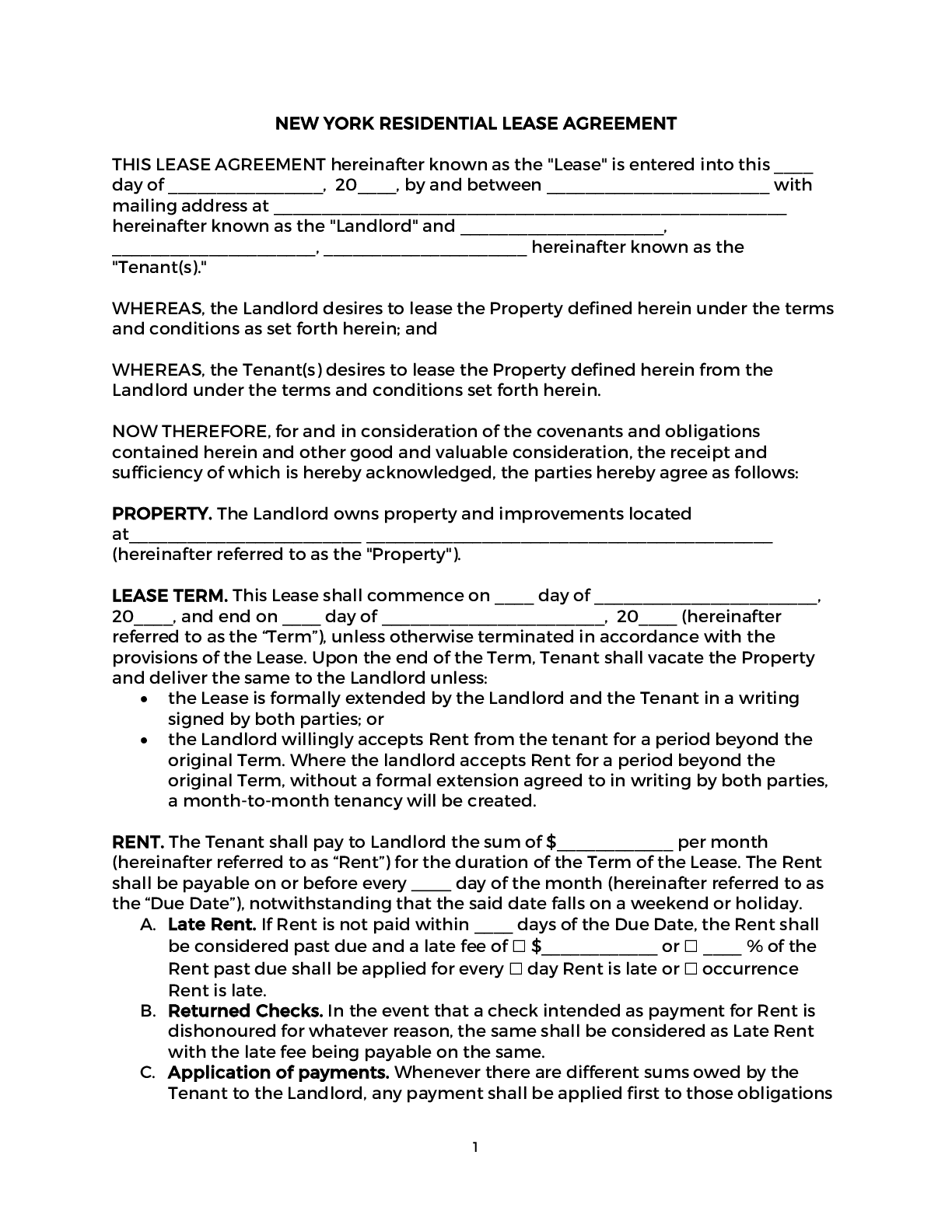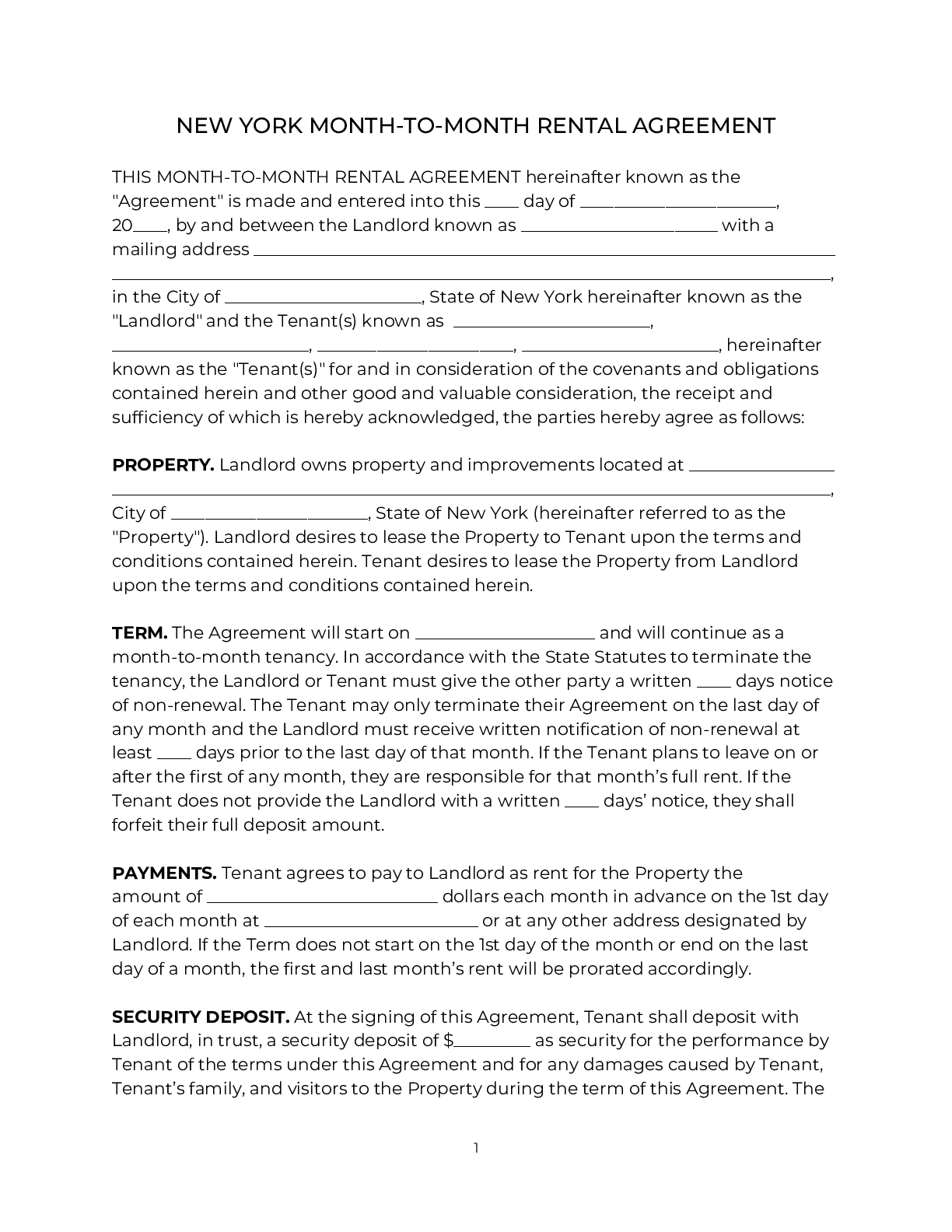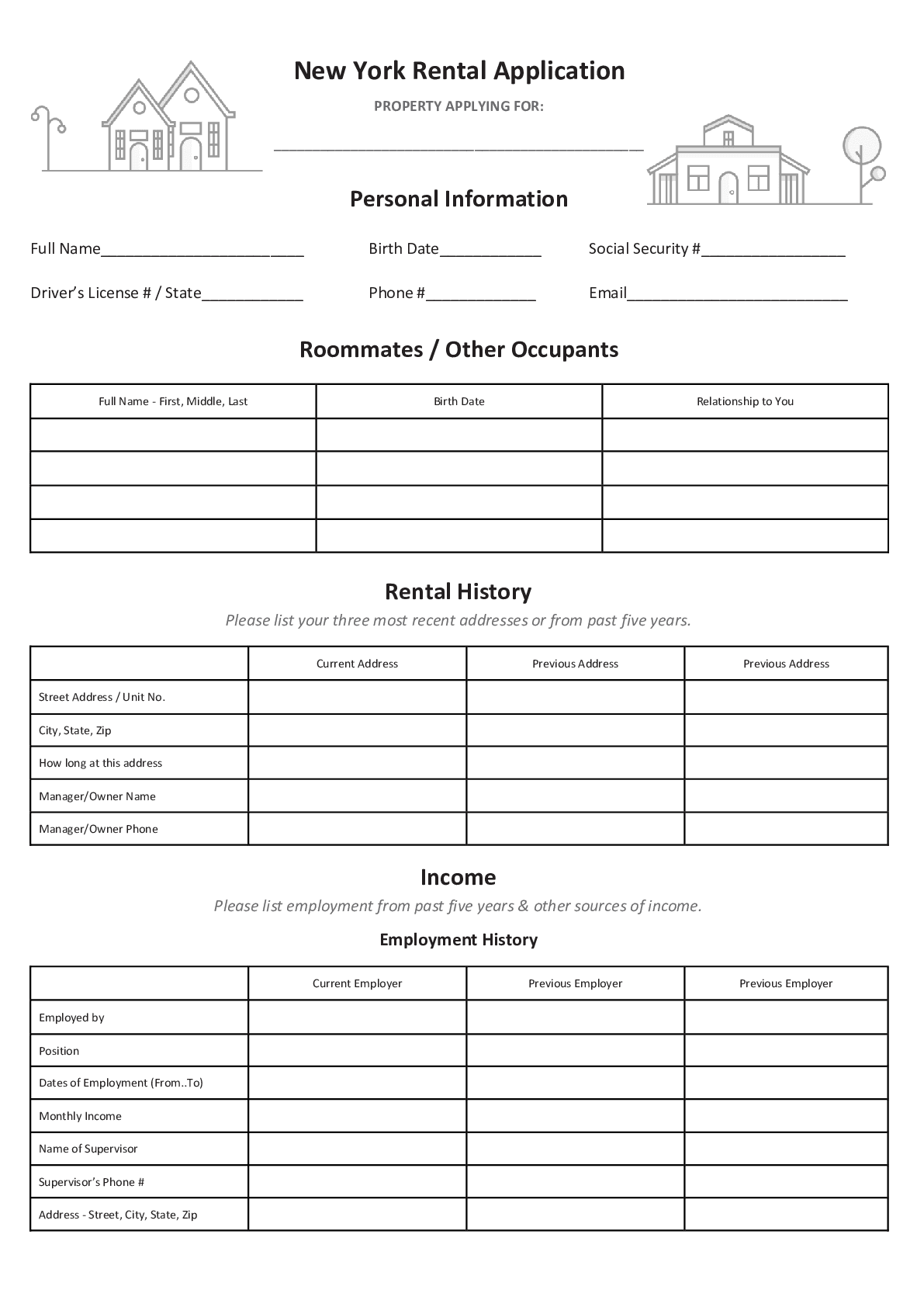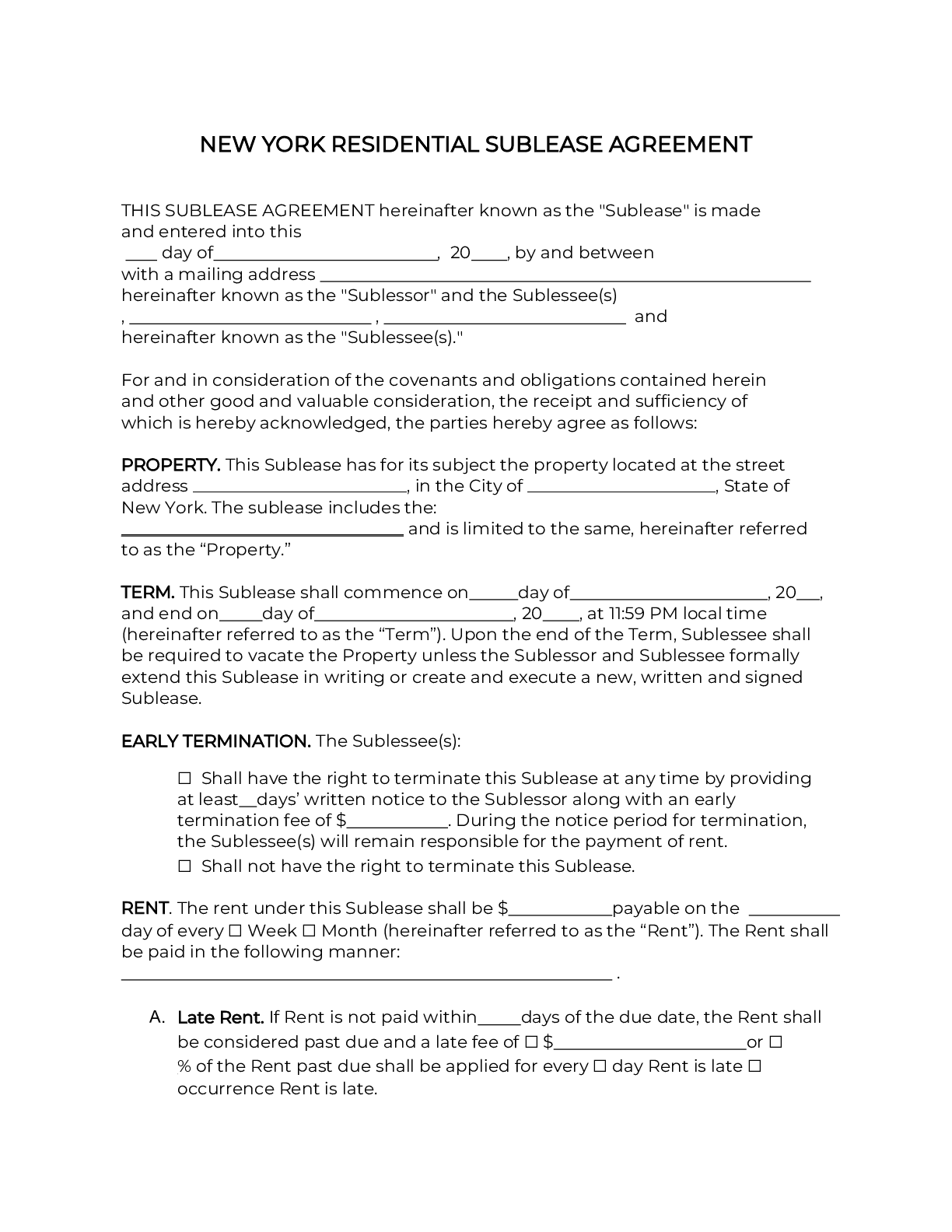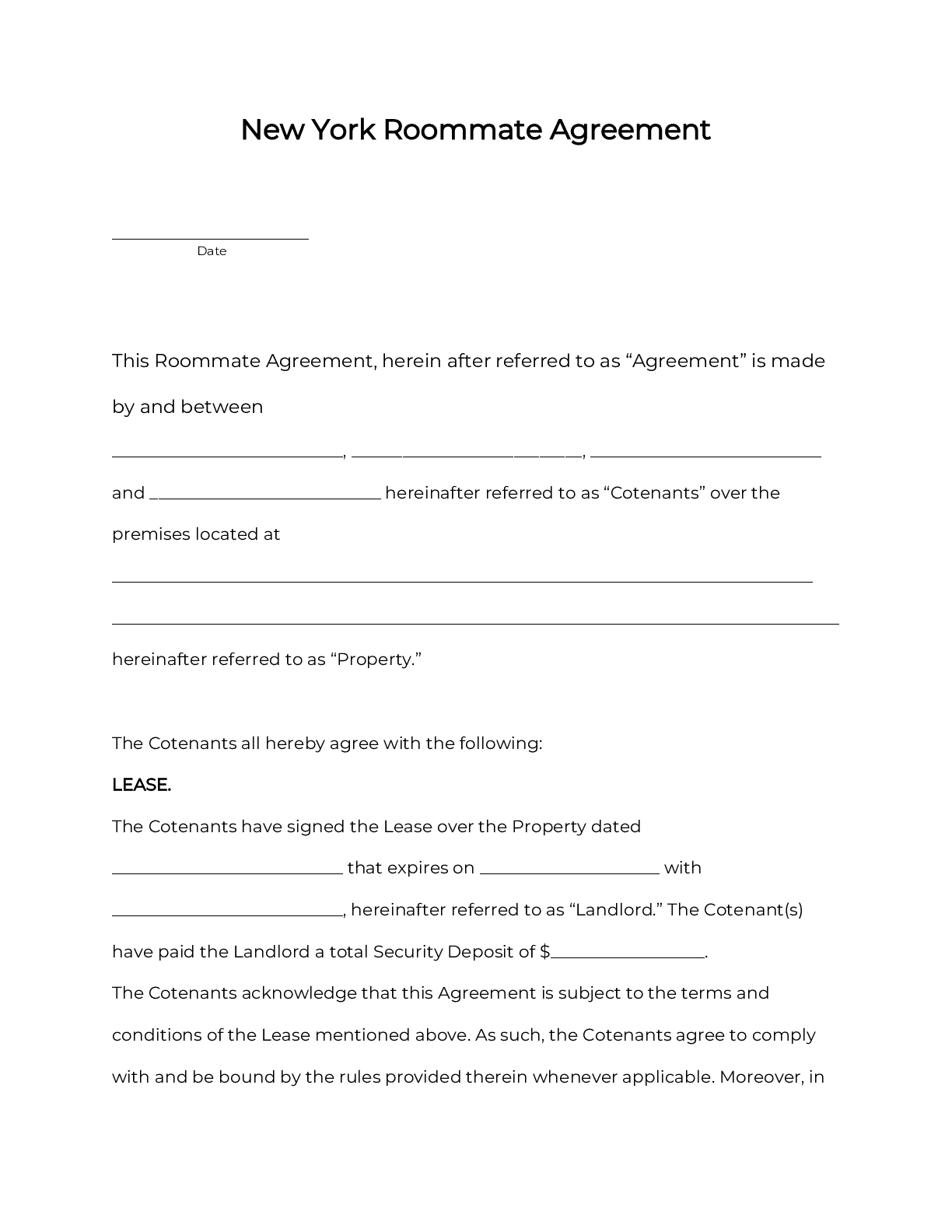A New York rental agreement is a legal contract between a landlord overseeing a rental property and a tenant using the property. Delaware landlord-tenant law governs and regulates these agreements.
New York Rental Agreement Types
A New York roommate agreement is a legal contract between two or more people (“co-tenants”) who share a rental property according to rules they set, including for things like splitting the rent. This agreement binds the co-tenants living together, and doesn’t include the landlord.
Common Rental Agreements in New York
- New York Residential Lease Agreement– The New York Multiple Listing Network provides this lease template for residential use. It details numerous rules and procedures, including the tenant’s responsibility for the condition of the rental unit.
- New York Renewal Lease Form – This two-section form is for rent stabilized units in New York. Section A indicates the rental price, costs and fees, and the landlord’s offer to the tenant to renew. Section B indicates whether the tenant accepts or declines the landlord’s offer.
- The New York City Bar Office Lease – The New York City Bar provides this template for use in commercial office rentals. It details numerous rules and procedures, including exhibits such as landlord regulations, provisions for a standby letter of credit, etc.
- The New York City Bar Retail Lease – The New York City Bar provides this form for renting commercial retail spaces. It outlines New York’s property rules and procedures, and details elements like signage, shared common areas, and subletting policies.
New York Required Lease Disclosures
- Operative Fire Sprinkler System Notice (required for all leases) – All New York lease agreements must include a notice, written in bold-face font, outlining the presence and maintenance history of sprinkler systems on the property.
- Good Cause Eviction Notice Disclosure (required for all leases) – All New York landlords, when executing or renewing a lease, must present a long and specific notice about the applicability of the state’s good-cause eviction law.
- Security Deposit Holdings (required for some leases) – New York landlords must provide a written disclosure of how they will hold a tenant’s security deposit funds. This disclosure must include the name of the holding institution, the location, and the sum of the holding. It may also include the account number.
- Shared Utilities Disclosure (required for some leases) – New York rental units which share a utility meter for the whole building or property require a disclosure on how the charges are billed to individual tenants.
- Bed Bug Disclosure (required for some leases) – New York City leases must include a disclosure of bed bug infestation history for the unit and the building.
- Lead-Based Paint Disclosure (required for some leases) – Landlords must provide an EPA-approved disclosure and informational pamphlet to tenants renting any property built before 1978.
To learn more about required disclosures in New York, click here.
New York Landlord Tenant Laws
- Warranty of Habitability – New York landlords can only rent out habitable property. This means providing certain basic health and safety features like heat, plumbing, and electricity. New York also guarantees the tenant’s right to other features, like a mailbox and smoke/carbon monoxide detectors. Landlords must repair any issues within a reasonable time after proper notice. A tenant might sue a noncompliant landlord, or repair and deduct.
- Evictions – New York landlords may evict tenants for a number of reasons such as failure to pay rent, a lease violation, or illegal acts. Depending on the type of eviction, a landlords must provide notice to pay, comply or quit before filing. Most evictions in New York take over a month.
- Security Deposits – New York limits a security deposit to one month’s rent. When the lease ends, the landlord must return any unused portion of a tenant’s deposit within 14 days.
- Lease Termination – Month-to-month New York tenants can end a lease by providing one month of advance notice. Terminating a fixed-term lease usually requires active military duty, domestic violence/stalking, landlord harassment, uninhabitable property, advanced age/health issues, etc.
- Rent Increases and Fees – New York has rent control for some property (dwellings built prior to February 1, 1947, occupied by the tenant/family since July 1, 1971). The law requires advance notice when the rent will increase by 5% or more. The notice period depends on how long the tenant has occupied the unit. The state limits late fees to $50 or 5% of the monthly rent (whichever is less). Bounced check fees have a $20 cap.
- Landlord Entry – Tenants must give the landlord access to the property for necessary repairs. Except in an emergency, the landlord must give “reasonable” advance notice (by custom, at least 24 hours).
- Settling Legal Disputes – New York allows landlord-tenant claims in either small claims court or local court. The maximum value in controversy for small claims ranges from $10,000 in New York City, to $3,000 in town and village courts. Eviction cases are limited to state civil courts.
To learn more about landlord tenant laws in New York, click here.
Sources
- 1 N.Y. Real Prop. Law § 231-C
-
A landlord as defined in subdivision two of section two hundred eleven of this chapter shall append to or incorporate into any initial lease, renewal lease, notice required pursuant to paragraph (a) of subdivision one of section two hundred twenty-six-c of this article, notice required pursuant to subdivision two of section seven hundred eleven of the real property actions and proceedings law, or petition pursuant to section seven hundred forty one of the real property actions and proceedings law, the following notice: [notice omitted here for reasons of length, but available at the primary source link provided.]
Source Link - 2 N.Y. Gen. Oblig. Law § 5-328(3)
-
Notwithstanding any other provision of law, any person to whom a check, draft or like instrument, other than a money order, bank cashier’s check or certified check, is tendered for any transaction, other than a consumer transaction, may, if such instrument is dishonored charge or collect from the maker or drawer the amount of twenty dollars for the return of such unpaid or dishonored instrument.
Source Link




